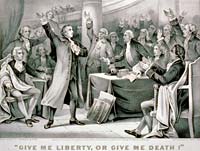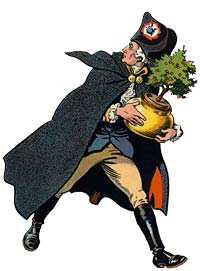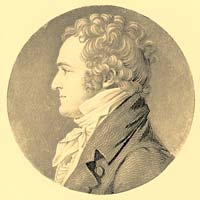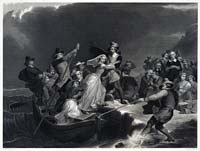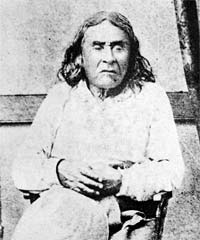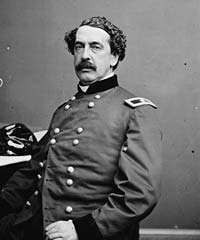Online Extras
Zoom in on “The Use of Myth in History” Prints


Library of Congress
Pocahontas, perhaps eleven or twelve at the time, did not save John Smith from death out of love for him.
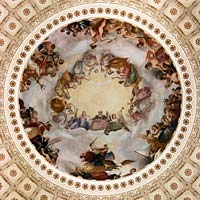
Architect of the Capitol
The Apotheosis of Washington in the Rotunda of the Capitol makes a god of the first president.
The Use of Myth in History
Many Myths Are Designed to Explain Us as We Wish to See Ourselves
by Gil Klein
The crowd waited expectantly as Adrian Grantz, portraying Patrick Henry, rose to reenact the culmination of the debate of the Second Virginia Convention of March 1775. A couple hundred people from all over the country packed into Richmond's St. John's Church, the site of the original speech, as they do nearly every Sunday.
The words tripped out of Grantz's mouth as the hushed audience waited for the famous concluding lines.
"Gentlemen may cry, Peace, Peace—but there is no peace," Grantz said, his voice rising for the finale. "The war is actually begun! The next gale that sweeps from the north will bring to our ears the clash of resounding arms! Our brethren are already in the field! Why stand we here idle? What is it that gentlemen wish? What would they have? Is life so dear, or peace so sweet, as to be purchased at the price of chains and slavery?"
Then, in a gesture that has been repeated by generations of schoolchildren, he raised his arms as though breaking the chains.
"Forbid it, Almighty God! I know not what course others may take; but as for me, give me liberty or give me death!"
Cheers and applause. People stood in ovation.
Henry's "Liberty or Death" became a slogan useful in situations where action is summoned to defeat perceived tyranny.
But the historical fact is that though Henry did speak forcefully on that March day to spur the convention to action, we have no reliable record of what exactly he said.
The speech children have memorized for almost two centuries was committed to paper in 1817 by William Wirt, forty-two years after the event, in his biography of Henry. It was based on a recollection—not notes—of someone who had been there, Williamsburg's St. George Tucker. Wirt, who became attorney general of the United States, was himself an orator, but his best-known speech he took from Tucker and put in Henry's mouth.
Indeed, around the time Wirt wrote about Henry, amateur historians were crafting tales of the American Revolution as well as of the colonial era that were designed less to capture the facts than to create a founding myth for the young republic.
In the view of professional historians, these myths should be punctured. But historians do so at their peril. The myths are more beloved than the cold facts, and they are hard to kill.
Many of them are designed to explain us as we wish to see ourselves. They establish the national character and set the standard for coming generations.
Writer Joseph Campbell said that all cultures are based on myths: "What these myths have given has been inspiration for aspiration." Columnist Michael Gerson wrote of myth: "When these strings are touched, we feel the vibrations deep down. And we know that myths are not the same as lies."
The Past and history are different things, wrote British historian J. H. Plumb. People have always used The Past to explain the origins and purpose of human life, to sanctify government institutions, to validate class structure, to provide moral example. Only in the past two or three hundred years, he said, has historical study developed "to see things as they really were."
Said historian John Thorn, "Historians have an obligation to embrace myth as the people's history."
Unlike countries whose founding myths developed during the course of centuries, the American mythos was created largely by one generation writing in the early 1800s, said Ray Raphael, author of Founding Myths: Stories That Hide Our Patriotic Past.
"About twenty years had to go by before people could forget how ugly the Revolutionary War was," Raphael said. "As pressure built toward the War of 1812, people saw a need to develop in the younger generation a pride in their revolutionary heritage. They knew this experiment in republican government needed people who believe in it and are willing to defend it."
In 1790, Noah Webster wrote that "every child in America, as soon as he opens his lips . . . should rehearse the history of his country; he should lisp the praise of Liberty and of those illustrious heroes and statesmen who have wrought a revolution in his favor."
The creation of these stories coincided with the birth of public education in America. The historical and moral lessons imparted by Parson Weems about George Washington and the cherry tree or Longfellow's "Midnight Ride of Paul Revere" or the Pilgrims landing at Plymouth Rock or John Smith's disputed rescue by Pocahontas became enshrined in textbooks for the masses.
Most of the American myths are based on historical fact. Henry did give a rousing speech to inspire the Virginia Convention to create a militia. The Pilgrims did settle Plymouth. An Indian girl by the name of Pocahontas was a figure in the settling of Jamestown. Paul Revere did ride into the Massachusetts countryside to warn that British soldiers were coming. Washington did try to live a virtuous life, though, cherry tree or not, he probably told a few lies.
The writers of these tales took those kernels of truth and embellished them, made them sound more romantic and uplifting than perhaps they were, and drove home a moral message designed to educate and inspire a new generation.
As every good storyteller knows, focusing on an individual's exploits creates a better tale. Make one person the hero, and readers and listeners will be engaged.
The writers of the nineteenth century, seeking a unifying power, made Washington the embodiment of a nation of contentious states. He, more than the flag, symbolized the United States. And without a doubt, Washington was the unifying force that made the Constitution possible.
But mythmaking? Stand in the Rotunda of the United States Capitol and look straight up. You see Constantino Brumidi's frescoe The Apotheosis of Washington, begun six years before the Civil War and completed in 1865. "Apotheosis" means transformation into god.
James Rees, the president of the Mt. Vernon Ladies Association, says that stripped of myth, Washington is still "America's first superhero."
Every good writer of history must first study the myths, author Raphael said. "You just kind of grandfather in these mythological aspects unless you are willing to examine them from scratch."
Making myths is an industry in Hollywood. Amy Henderson, the curator of popular culture at the National Portrait Museum in Washington, says, "One of the chief elements of American character is our ability to invent ourselves." She quotes from director John Ford's Man Who Shot Liberty Valance, who said, "When the legend becomes fact, print the legend."
Take the words of Chief Seattle, a nineteenth-century American Indian from Puget Sound, which inspired the modern environmental movement. Books, magazine articles, and environmental advocacy groups have trumpeted his lyrical message of 1854, words that extolled harmony with nature:
"I have seen a thousand rotting buffaloes on the prairie, left by the white man who shot them from a passing train. I am a savage and do not understand how the smoking iron horse can be made more important than the buffalo that we kill only to stay alive."
Though Chief Seattle existed, and he may have said something profound in 1854, he certainly did not mention railroads or buffalo or prairies, because he had not seen any of them, and the massacre of buffalo hadn't happened yet.
A Hollywood scriptwriter wrote the words in 1971. "It's very similar to the Patrick Henry speech," Raphael said. "Someone with a point to make takes an historical person who is close to making that same point and writes a speech for him using the current language that would resonate to the people of the times."
Ethan Allen knew how to make his own myth. At Fort Ticonderoga, historic interpreter Gordon Hamilton, dressed in the garb of a New York militiaman in the French and Indian War, leads visitors through the history of the fort, culminating in its capture at the beginning of the Revolution by Ethan Allen and the Green Mountain Boys, heroes of the state of Vermont.
Hamilton dramatically recounts Allen's words when a British officer asked by whose authority he invaded the fort: "In the name of the Great Jehovah and the Continental Congress I am taking this fort."
Then he pauses. At least that's what Allen said he said when he wrote his memoirs. The Second Continental Congress had not yet met and had not authorized taking the fort. In fact, its first reaction was to give the fort back to the British. What Allen did say was more prosaic. According to firsthand accounts, Allen demanded of the fort's second-in-command that he get the commanding officer: "Bring the old rat out, or I'll run him through."
"That reality is kind of tough, especially on the Vermonters who come here," Hamilton said. "Ethan Allen is their folk hero. They were raised to revere him. They know that statement by heart. They feel sure he said it."
Writer Tony Horwitz traveled all over the Americas tracing the stories and travels of the early explorers from Christopher Columbus to the Pilgrim landing for his book A Voyage Long and Strange. Everywhere, he said, he found legends and myths—and people who didn't want to know otherwise.
"I came to the conclusion that no amount of fact is ever going to somehow triumph over these myths," Horwitz said. "They are with us. People cherish them and need them. They are comforting stories that we tell about ourselves."
Ex-Confederate generals eager to tell their side of the Civil War created the Lost Cause myth within a couple of years of the end of the conflict. In their minds, the war was not about slavery. Abolitionists caused it, and the North ground down the cultured and gallant South through overwhelming numbers and matériel. Robert E. Lee was the greatest general who ever lived. Ulysses S. Grant was a butcher.
"In terms of shaping how Americans have assessed and understood the Civil War, Lost Cause warriors succeeded to a remarkable degree," wrote Gary W. Gallagher in his book The Myth of the Lost Cause and Civil War History.
Suffering in all of this were the ex-slaves who saw the rights they gained during Reconstruction disappear for nearly a century as Northern and Southern whites embraced the Lost Cause myth to reunify the nation.
"Many, if not most, Americans still see the Civil War era through the prism of Gone with the Wind," said Horwitz, whose latest book, Midnight Rising, recounts John Brown's story. "Gone with the Wind, both the book and the movie, have had more impact on how Americans think about the Civil War than the hundreds of thousands of scholarly works that have been written."
Though most American myths are created from a kernel of truth, some are just flat-out made up to achieve a historical purpose.
Walk into the Baseball Hall of Fame in Cooperstown, New York, and right at the beginning is a portrait of Abner Doubleday. Next to it is the caption: "Abner Doubleday was a career U.S. military officer and Union general in the Civil War. Prior to entering the military, he attended school in Cooperstown and the Military Academy at West Point, graduating in 1842. Although Doubleday had a distinguished military career, he is best known as the supposed inventor of baseball."
Catch the weasel word? "Supposed."
Not only did Doubleday not invent baseball, no evidence exists that he ever played it, said John Thorn, the official historian of Major League Baseball, whose recent book is the latest to try to puncture that myth.
In the early part of twentieth century, Thorn said, Albert G. Spalding, a former player and subsequently a sporting goods magnate and National League official, was desperate to prove that baseball was purely an American invention. He wanted to counter claims from a British-born writer that the game originated in England.
He created a commission to explore the origin of baseball. It latched onto a letter written to it by a "demented mining engineer" from Colorado, who claimed that at the age of five, he was in Cooperstown and played with Doubleday as he invented baseball in 1839, according to Thorn.
But Doubleday was at West Point as a cadet without leave in 1839, Thorn said. In his memoirs, Doubleday never mentioned baseball. He did "invent" one piece of American history. He was at Fort Sumter and fired the first shot in reply to the Confederate bombardment. In a sense, he invented the Civil War.
On the hall of fame's third floor, a placard says Spalding invented the Doubleday myth in a "patriotic desire to see the sport as purely an American invention." But on the first floor, a placard says the museum owns the baseball used by Doubleday to invent the game.
"Abner Doubleday, despite my best efforts, will continue as the Father of Baseball the same way that Santa Claus will continue as the Father of Christmas," Thorn said. "We use myth and lie interchangeably. But they are not. Myth is more powerful than fact."
Virginia-based journalist Gil Klein was a national correspondent for the Media General News Service in Washington, is a past president of the National Press Club, and is an American University assistant professor. He contributed to the winter 2011 journal a story about the myths of the Declaration of Independence.
Suggestions for further reading:
- Gary W. Gallagher and Alan T. Nolan, eds., The Myth of the Lost Cause and Civil War History (Bloomington, IN, 2000).
- Tony Horwitz, A Voyage Long and Strange: Rediscovering the New World (New York, 2008).
- J. H. Plumb, The Death of the Past (Boston, 1970).
- Ray Raphael, Founding Myths: Stories That Hide Our Patriotic Past (New York, 2004).
- John Thorn, Baseball in the Garden of Eden: The Secret History of the Early Game (New York, 2011).

